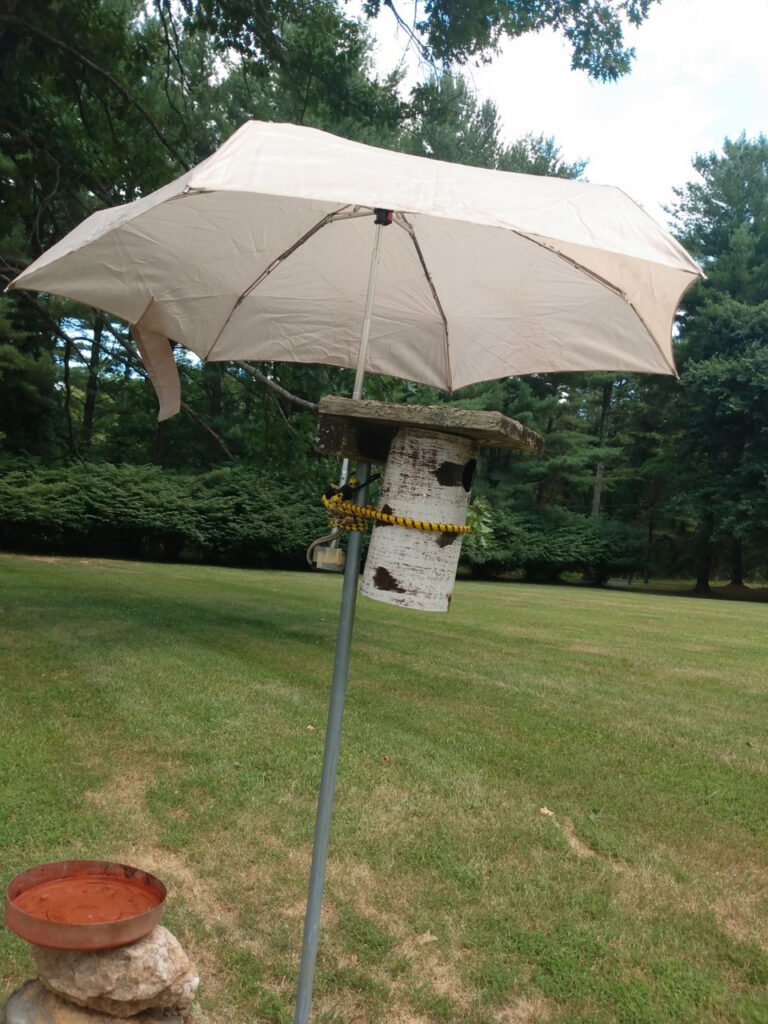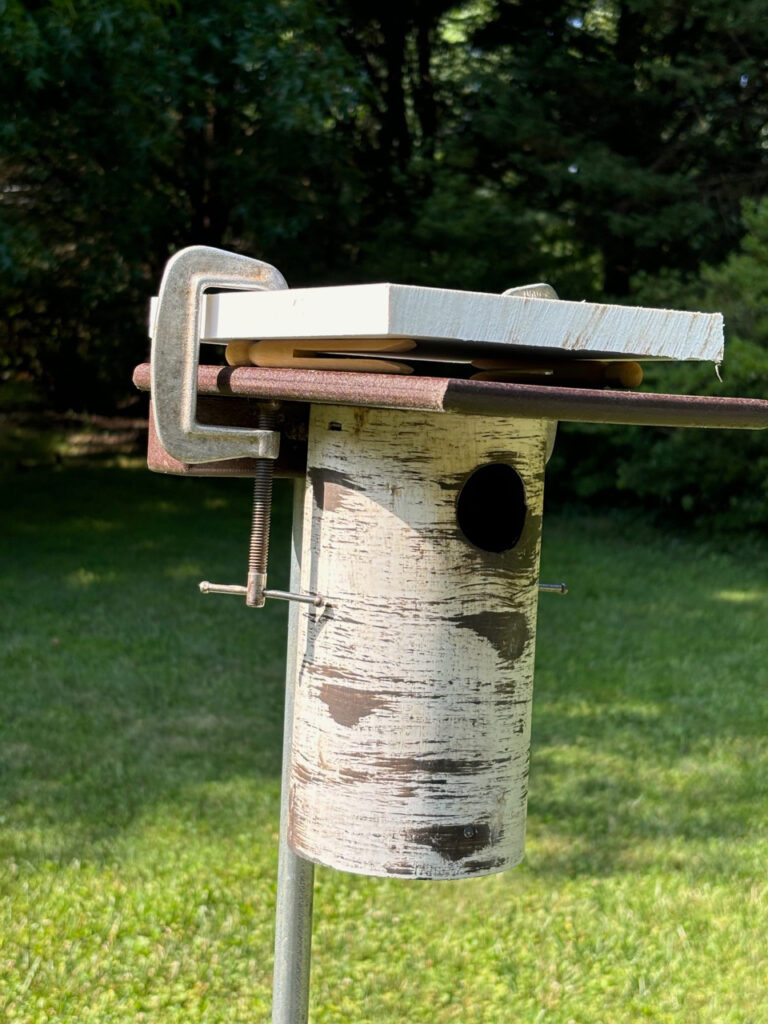How to help nesting Bluebirds survive extreme heat.
YES. Extreme heat can be dangerous for cavity nesting birds. It’s especially true for Bluebirds as they prefer nest boxes facing open areas, which exposes them to full direct sunlight.
To start, the sad fact is that when nest box interiors exceed 107° F, eggs won’t hatch and nestlings under nine days old can die from heat stress or dehydration. Prolonged heat at temperatures over 100° can also severely impact nestling health.
The temperature inside your nest box can be—at the very least—10 degrees higher than the outside temperature.
With current, prolonged heat indexes here, in the midst of nesting season, there is action we can all take to help our nesting birds get through this extreme hot weather.
What you can do ASAP:
1. Shade the Nest box – Think outside of the box.
- If your nest box is not shaded during the hottest part of the day (noon and onward), secure a light colored umbrella over the box. (See photos below and captions for examples.) Monitor the box to be sure the adults are ok with this addition. You don’t want to add more stress. If wind picks up or a thunderstorm is coming, take the umbrella down temporarily.
- If your nest box is under trees, make sure it’s far enough from large branches that could give climbing predators an opportunity to jump onto the box.
- Never remove nestlings from the box, or try to feed or hydrate them yourself. Mama and Papa will take care of this part.
2. Prevent Dehydration – Your bird bath is key.
- Keep your bird bath fresh and topped up for the adults and fledglings.
- If you are offering the adults dried mealworms, please moisten them with water. Baby Bluebirds, like other cavity nesting baby birds, get moisture from the food their parents bring them, like juicy insects, seeds and fruit. This is the ONLY source they need, so you are indirectly augmenting the nestlings’ diet.
- NEVER USE PESTICIDES!!! The insects eat them, birds eat the insects and also feed them to their babies. We are hearing about multiple nestling and adult deaths due to these poisons. Please share this info with your friends and neighbors. This is a preventable tragedy, and it’s tragic beyond measure. FYI, many weed-killers, yard treatments for mosquitoes, lawn chemicals, etc have been banned under the The Montgomery County Pesticide Law. Find out more here.
3. Add Temporary Heat Shields to Nest boxes
It’s possible to add extra heat protection with minimal disruption in between broods after they fledge and while you’re cleaning the box. For example, see how customer Betsy Taylor took emergency action and quickly lowered the temperature in her nest boxes using items she had on hand and could install quickly. See photos and captions on the right (or scroll down if you’re viewing on a small screen).
4. Do everything with minimal disruption.
Ongoing, save any permanent, major renovations for after nesting season or as you clean the box between broods. Bonus! Many of these adaptations will also help keep the box warmer during extreme cold temperatures, too. Sheltering songbirds will thank you!
Some of these ‘improvements’, may include:
- Adding a double roof with extra overhang.
- Insulating the box.
- Providing extra ventilation.
- Don’t paint or stain nest boxes a dark color.
- Attach permanent heat shields and/or screens. There’s a great example on the Sialis website, link below.
Check out the Sialis.org article here for in-depth information on simple ways to adapt your nestbox to stay cooler. You’ll find a list of specific materials with details on how to best apply them. We’re here to help if you have any questions. Also, visit our Bluebird resource page for all things Bluebird!
Take action! You can make a difference.
In conclusion, during this stretch of 95+° days, it’s critical to take action! With quick thinking and creative use of household items, you could help your Bluebird nestlings survive. Just a few degrees cooler can make a difference.
Now, some good news!
Finally! Now for some good news! Bluebird Conservation efforts in our area have been tremendously successful, not just by increasing Bluebird populations locally, but also by inspiring other conservation efforts nationally. It all started here in Silver Spring, with The North American Bluebird Society! Together, we really can make a difference!
We encourage you to join The Maryland Bluebird Society that coordinates local conservation efforts.
The mission of the Maryland Bluebird Society is to assist in monitoring and increasing the population of the Eastern Bluebird and other native cavity-nesting birds through education, support and research. MBS will also cooperate with other organizations with similar conservation purposes.
From The Maryland Bluebird Society website
Thank you for supporting wild birds! Also, a huge thank you to our customer, Betsy Taylor for sharing her photos and creative solutions with us.
Debi, Mike and The Backyard Naturalist Team
Let’s all stay cool!

Betsy Taylor’s creative and quick solutions to lower temperatures in her Bluebird nest boxes.
This week, while outdoor temperatures were rising closer and closer to 100°, customer Betsy Taylor observed nestlings in distress from the heat.
After a quick consultation with Pete Givan at The Backyard Naturalist, they came up with a simple emergency solution: attaching a light-colored umbrella to the pole with zip ties.
Betsy’s sister took immediate action, using items she had on hand. Home alone, she installed the umbrella herself in about five minutes “using bungie cord and two hands, a shoulder, and one nose to hold it all in place while she managed to wrap the cord around the box”. This is a temporary solution, Betsy emphasizes and they will take it down if wind gusts or storms are eminent.
Betsy Solution #2

Betsy assembled what she had on hand in this emergency situation: two C-clamps, two wooden clothespins and a scrap board already painted white. Spacing the double ‘roofs’ is important to allow air flow.
At 4 p.m., right after installation, Betsy’s instant read thermometer measured the nestbox interior as 102°! Measuring again ten minutes later, the interior temperature had fallen to 98°.






